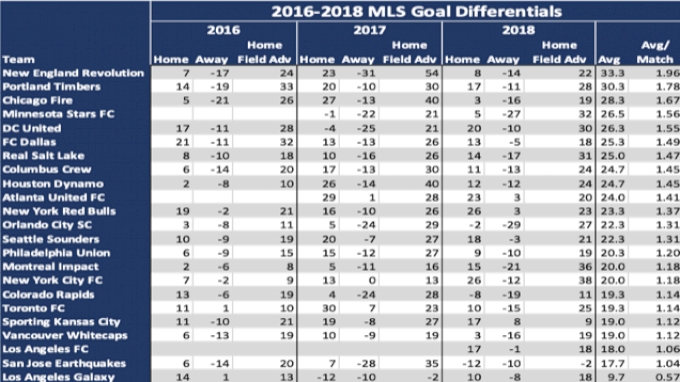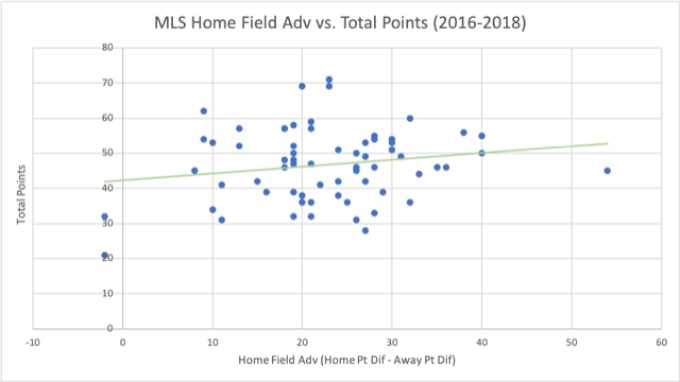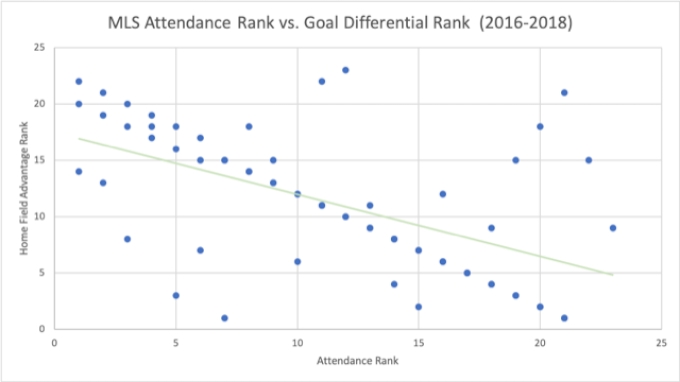Parsing The Numbers: Goal Differential & Home-Field Advantage In The MLS
Parsing The Numbers: Goal Differential & Home-Field Advantage In The MLS
FloFC crunched the numbers to take a deep dive into home-field advantage in Major League Soccer.

No matter the sport, it has always been said that there are certain advantages to playing at home. Whether it’s the roaring of the crowd that brings out the best in players, the social pressure placed on the referees or simply the advantages of playing on a familiar pitch, playing at home does significantly increase a team’s likelihood of winning. But just how much does it change a team’s outcome? Are different teams affected differently when playing on their home turf? If so, what are the variables that contribute to these differences? While we here at FloSports have previously looked at the effects of home court advantage in the Euroleague, today we will look at which MLS teams have performed most differently at home versus on the road.
We did this by first taking each team’s head-to-head matchups against every other team over the past three seasons, finding the goal differential when they played at home versus at the other team’s arena and then summing this out across all team matchups. Each year, teams played a total of 17 matches at home and 17 matches away. The results are below. (Missing data is due to teams not yet having joined the MLS.)

Goal differentials for the last three MLS seasons.
An initial cursory look over the table reveals that, yes, MLS teams do indeed have better goal differentials at home than on the road. More surprising than this, however, is the absolute size and unanimity of the difference in performance between the two. Over the course of the past three seasons, teams have out-scored their opponents by nearly 1.33 goals more at home than on the road. And this is nearly completely universal. Despite their overall records, over the past three seasons, 92% of teams have had a positive goal differential at home and 89% have had a negative goal differential on the road. Regardless of the overall skill of the team, it appears that in the MLS, it is really, really hard to consistently win on the road. Only two teams over 65 team seasons have ended the season with a negative home court advantage.
It also appears that just because a team has a high average home-field advantage doesn’t necessarily mean they are a good team. In fact, most of the teams with the largest home-field advantages are less likely to play particularly well at home and more likely to play particularly poorly on the road.
Below is a graph of a team’s home-field advantage in a given season versus their end of season point total.

The line of best fit of this scatterplot is relatively flat, indicating that there is very little association between greater home-field advantage and more overall points. Adding further evidence to the idea that the teams with the best home-field advantage are not so much dominant at home as poor on the road is that there does not seem to be a positive association between larger crowds and greater home-field advantage. If teams truly were performing better because of the environment at home, one variable we might expect to capture this effect is average attendance. However, if we look at attendance ranks over the past five years, what we see is actually quite the opposite.

The higher a team ranks in attendance (with one being the highest and 23 being the lowest), the lower it usually ranks in home-field advantage. This runs exactly opposite to expectations that teams with more fans at the game would perform better at home. However, these two variables are not entirely independent. One alternative explanation is that the better teams play more consistently at home and on the road, and more fans will show up for the home games of better teams.
Regardless of the causal links, it is clear that MLS teams nearly universally perform better at home than on the road, with teams like the New England Revolution and Portland Timbers outscoring their opponents by nearly two more goals per game over the past three years when playing at their home stadium, but that overall having a strong home-field advantage does not seem to correlate with better end-of-season results. Nearly all teams will end the year with positive goal differentials at home and negative goal differentials on the road, but the very best teams manage to find ways to keep their play consistent regardless of where the match is being hosted.
Fri Lavey is a writer and consultant who studied economics and statistics at Harvard University. He has previously worked as a data analyst for the NBA, the MLB, and the Philadelphia 76ers.
Related Content
 How to Watch: 2024 Smith College vs Springfield - Women's | Soccer
How to Watch: 2024 Smith College vs Springfield - Women's | SoccerMar 14, 2024
![How to Watch: 2024 Salve Regina vs Wellesley College[a] - Women's | Soccer](https://d2779tscntxxsw.cloudfront.net/5d1b91f16a42a.png?width=400&quality=80) How to Watch: 2024 Salve Regina vs Wellesley College[a] - Women's | Soccer
How to Watch: 2024 Salve Regina vs Wellesley College[a] - Women's | SoccerMar 14, 2024
 How to Watch: 2024 Mount Holyoke College vs W.P.I. - Women's | Soccer
How to Watch: 2024 Mount Holyoke College vs W.P.I. - Women's | SoccerMar 14, 2024
 How to Watch: 2024 Emerson College vs M.I.T. - Women's | Soccer
How to Watch: 2024 Emerson College vs M.I.T. - Women's | SoccerMar 14, 2024
![How to Watch: 2024 Wellesley College[a] vs M.I.T. - Women's | Soccer](https://d2779tscntxxsw.cloudfront.net/5d1b91f16a42a.png?width=400&quality=80) How to Watch: 2024 Wellesley College[a] vs M.I.T. - Women's | Soccer
How to Watch: 2024 Wellesley College[a] vs M.I.T. - Women's | SoccerMar 14, 2024
 How to Watch: 2024 Babson College vs Clark - Women's | Soccer
How to Watch: 2024 Babson College vs Clark - Women's | SoccerMar 14, 2024
 How to Watch: 2024 Springfield vs Babson College - Women's | Soccer
How to Watch: 2024 Springfield vs Babson College - Women's | SoccerMar 14, 2024
 How to Watch: 2024 W.P.I. vs Emerson College - Women's | Soccer
How to Watch: 2024 W.P.I. vs Emerson College - Women's | SoccerMar 14, 2024
 How to Watch: 2024 United States Coast Guard Academy vs Salve Regina - Women's | Soccer
How to Watch: 2024 United States Coast Guard Academy vs Salve Regina - Women's | SoccerMar 14, 2024